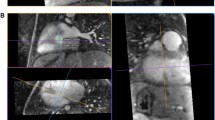Summary
A three-dimensional (3-D) computer assisted reconstruction of the biliary tract was performed in human and rat embryos at Carnegie stage 23 to describe and compare the biliary structures and to point out the anatomic relations between the structures of the hepatic pedicle. Light micrograph images from consecutive serial sagittal sections (diameter 7 mm) of one human and 16 rat embryos were directly digitalized with a CCD camera. The serial views were aligned automatically by software. The data were analysed following segmentation and thresholding, allowing automatic reconstruction. The main bile ducts ascended in the mesoderm of the hepatoduodenal ligament. The extrahepatic bile ducts: common bile duct (CD), cystic duct and gallbladder in the human, formed a compound system which could not be shown so clearly in histologic sections. The hepato-pancreatic ampulla was studied as visualised through the duodenum. The course of the CD was like a chicane. The gallbladder diameter and length were similar to those of the CD. Computer-assisted reconstruction permitted easy acquisition of the data by direct examination of the sections through the microscope. This method showed the relationships between the different structures of the hepatic pedicle and allowed estimation of the volume of the bile duct. These findings were not obvious in two-dimensional (2-D) views from histologic sections. Each embryonic stage could be rebuilt in 3-D, which could introduce the time as a fourth dimension, fundamental for the study of organogenesis.
Résumé
Une reconstruction tridimensionnelle assistée par ordinateur de l'arbre biliaire a été réalisée chez des embryons de rats et un embryon humain pour décrire et comparer les structures biliaires et pour mettre en évidence les rapports anatomiques des différents éléments du pédicule hépatique. Des coupes sagittales (épaisseur de 7 µm) d'un embryon humain et de 16 embryons de rat ont été directement acquises par ordinateur. Les coupes sériées ont été automatiquement alignées. Les données ont été analysées en utilisant une segmentation et un seuillage permettant une reconstruction automatique. Les voies biliaires principales avaient un trajet ascendant dans le mésoderme du ligament hépato-duodénal. Les voies biliaires extra-hépatiques : conduit cholédoque (CD), conduit cystique et la vésicule biliaire chez l'humain, étaient en continuité. L'ampoule hépato-pancréatique a été explorée par transparence à travers le duodénum. Le CD avait un trajet en chicane. Le diamètre et la longueur de la vésicule biliaire étaient identiques à celles du CD. La reconstruction assistée par ordinateur permet une acquisition aisée des données par l'examen direct des coupes histologiques à travers un microscope. Cette méthode détermine clairement les relations entre les différents éléments du pédicule hépatique et leur volume, ce qui n'était pas évident à l'examen en 2 dimensions des coupes histologiques. Chaque stade embryonnaire pourrait être ainsi reconstruit en 3-D, introduisant ainsi le temps comme quatrième dimension, ceci étant fondamental pour l'étude de l'organogénèse.
Similar content being viewed by others
References
Amiel M, Delattre JF, Cordobes B, Flament JB (1992) Computerized reconstruction of an anatomical structure based on digitized section. Anat Clin 5: 261–264
Arraez-Aybar LA, Mérida-Valasco J, Rodriquez-Vazquez J, Jiménez-Collado J (1994) A computerised technique for morphometry and 3D reconstruction of embryological structures. Surg Radiol Anat 16: 419–422
Born G (1883) Die Patten-Modelier-Methode. Arch Mikrosk Anat 22: 584–599
Deriche R (1990) Fast algorithm for low level vision. IEEE Transection Pattern Anal Machine Intell 12: 78–87
Gaubert-Cristol R, Godlewski G (1991) Identification of Point Scores at Stage 23 in the rat according to the system of scoring in the human embryo. Acta Anat 141: 364–368
Genis Galvez JM, Santos Gutierrez L (1963) El moltropen como materia prima en las reconstrucciones por el metodo de Born. An Desarrollo 11: 481–490
Godlewski G, Gaubert-Christol R, Rouy S, Prudhomme M (1997) Liver development in the rat and in man during the embryonic period (Carnegie stages 11–23). Micros Res Tech 39: 314–327
Hyde DM, Madigliano DJ, Reus E, Tyler NK, Nichols S, Tyler WS (1992) Computer-assisted morphometry: point, intersection, and profile counting and three dimensional reconstruction. Micros Res Tech 21: 262–270
O'Rahilly R, Muller F (1992) Human embryology and teratology. The digestive system. Wiley & Sons, New York, pp 139–181
Poelmann RE, Verbout AJ (1987) Computer-aided three-dimensional graphic reconstructions in a radiological and anatomical setting. Acta Anatomica 130: 132–136
Rosse C (1995) The potential of computerized representations of anatomy in the training of health care providers. Academic Medecine 70: 499–505
Rydmark M, Jansson T, Berthold C.H, Gustavsson T (1992) Computer-assisted realignment of light micrograph images from consecutive section series of cat cerebral cortex. J Microsc 165: 29–47
Salisbury JR (1994) Three dimensional reconstruction in microscopical morphology. Histol Histopath 9: 773–780
Van Biervliet A, Gest TR (1995) Techniques and tools for digitizing analog video for use in CD-ROM-based health education programs. Medinfo 2: 1222–1225
Watt ME, McDonald SW, Watt A (1996) Computer morphing of scanning electron micrographs: an adjunct to embryology teaching. Surg Radiol Anat 18: 329–333
Author information
Authors and Affiliations
Rights and permissions
About this article
Cite this article
Prudhomme, M., Gaubert-Cristol, R., Jaeger, M. et al. A new method of three-dimensional computer assisted reconstruction of the developing biliary tract. Surg Radiol Anat 21, 55–58 (1999). https://doi.org/10.1007/BF01635054
Received:
Accepted:
Issue Date:
DOI: https://doi.org/10.1007/BF01635054




